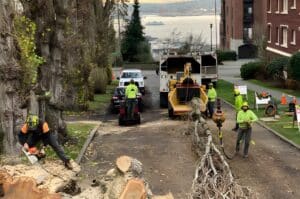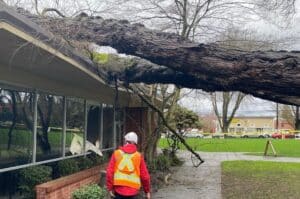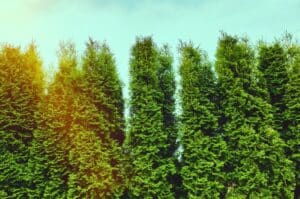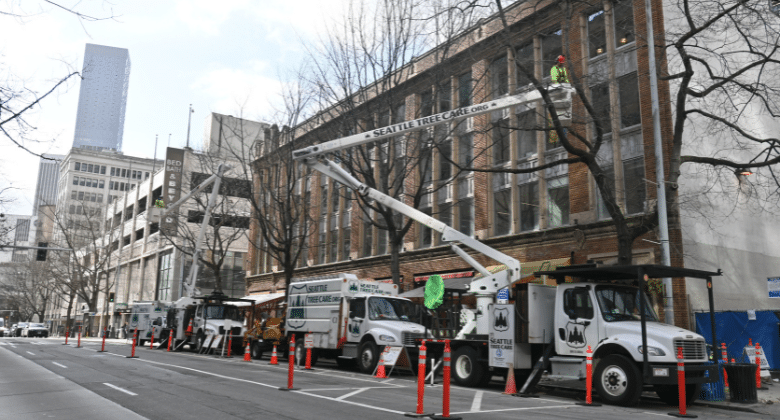How to Protect Your Seattle Trees from Drought Stress
Protecting Seattle trees from drought stress is easier than you think. Discover seasonal care tips, smart watering strategies, and simple routines that keep your trees thriving year-round.
Seattle’s lush tree canopy is what gives it the nickname “Emerald City.” But when maples crisp at the edges or firs drop needles in midsummer, it seems like the Emerald City is looking less and less…emerald.
These aren’t just aesthetic problems: they’re warning signs that protecting Seattle trees from drought stress has become more important than ever as our climate continues to change. As summers grow longer and drier, even our famously green city faces mounting challenges in keeping trees healthy and thriving. Fortunately, with the right knowledge and proactive tree care strategies, we can help protect the abundance of lush greenery that defines our city.
Key Takeaways
- Water trees once or twice weekly with 1-2 inches of water rather than daily light watering to encourage deep root growth in Seattle’s clay soils.
- Recognizing drought stress symptoms early prevents costly tree removal and protects property values in premium neighborhoods.
- Proper mulch application around trees can significantly cut watering requirements while improving soil structure in Pacific Northwest conditions.
- Professional inspections performed by an ISA Certified Arborist can help identify at-risk trees while ensuring compliance with Seattle’s complex tree protection code.
- Pacific Northwest natives like Douglas fir and western red cedar demonstrate better drought tolerance than non-native species when properly established.
- Coordinated neighborhood tree care in areas like Capitol Hill and West Seattle creates microclimates that benefit entire blocks while maintaining property values.
Seattle’s Urban Forest Faces Mounting Drought Pressure
Largely thanks to climate change, Seattle’s changing weather patterns are putting unprecedented stress on our urban canopy, and at an alarming rate. Between 2016 and 2021, Seattle lost 1.7% of its tree canopy, approximately 255 acres, which is made all the more concerning considering the population increased by 8.5% during the same period.
Without adequate and consistent water quantities, trees become increasingly vulnerable to diseases and destructive pests like bark beetles. Drought-stressed trees have a reduced ability to produce the sap and resin that normally defend against these pests, and once beetles establish themselves, they can kill healthy trees in the surrounding area, creating a cascade effect that devastates entire neighborhoods.
“We’re seeing more homeowners in neighborhoods like Wedgewood and Ballard calling about trees showing stress symptoms earlier in the summer than we used to. And the drought effects are cumulative; trees that dealt with multiple dry years are showing vulnerability even when we get adequate spring rainfall.” – Kelsey Gruenwoldt, owner of Seattle Tree Care
What’s making drought stress worse in Seattle?
Urban trees in the greater Seattle area face unique challenges that compound drought stress:
- Concrete and asphalt create heat islands that increase water stress
- Limited root space from infrastructure restricts trees’ ability to access groundwater
- Competition from lawn and landscaping often leaves trees fighting for available moisture
- Air pollution and urban dust interfere with normal leaf function
- Soil compaction from construction and foot traffic prevents proper water infiltration
These mounting pressures help explain why the Washington State Department of Ecology declared drought emergencies for much of the state in both 2024 and 2025. Even areas with adequate water supplies, like King County, feel the regional impact of extended dry conditions on forest health and urban tree survival.
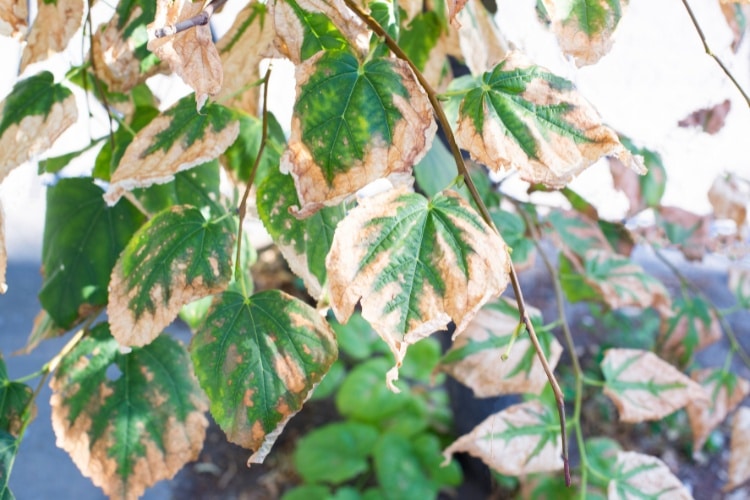
Many tree leaves in Seattle are showing signs of drought stress and leaf scorch, with brown, dry edges and green centers.
How to Recognize Early Drought Stress Signs in Seattle Trees
Catching drought stress early gives you the best chance of saving your trees and avoiding costly removal. Different tree species common in Seattle neighborhoods show distinct warning signs:
Signs of Drought Stress in Coniferous Trees (Douglas Fir, Western Red Cedar)
- Needle browning that starts at the branch tips and works inward
- Yellowish or bronze tint developing on normally green needles
- More severe discoloration on south-facing sides with greater sun exposure
Drought Stress Symptoms in Deciduous Trees (Bigleaf Maple, Japanese Maple)
- Leaf scorching along edges
- Premature leaf drop
- Wilting during the heat of the day that doesn’t recover in the evening hours
Indications of Drought Stress in Fruit Trees (Apple, Cherry)
- Premature fruit drop or failure to produce
- Sunken areas developing on the bark
- Leaves wilting despite adequate soil moisture around the base
Regardless of tree species, in Seattle’s climate, drought stress symptoms typically appear between mid-July and early September, coinciding with our driest period. However, trees weakened by previous drought years may show signs as early as June.
Proven Watering Strategies to Reduce Drought Impact in Seattle’s Climate Conditions
Effectively protecting Seattle’s trees from drought stress requires proper watering techniques and an understanding of our unique soil and weather patterns. Seattle’s heavy clay soils retain moisture well but can become compacted, which prevents water from penetrating. The key is deep, infrequent watering that encourages roots to grow down rather than spreading shallow.
Seasonal Drought Stress Prevention Watering Schedule
The best way to keep trees healthy during dry spells in the Seattle area is to adjust your watering schedule with the seasons. Here’s how to do it:
- Summer (June through August): Water established trees once per week with 1-2 inches of water. Newly planted trees need twice-weekly watering during their first two growing seasons.
- Early Fall (September): Reduce to every 10-14 days as temperatures cool and natural rainfall typically returns.
- Late Fall through Spring (October through May): Natural precipitation usually provides adequate moisture, though check soil conditions during unusually dry periods.
Best Tree Watering Techniques to Protect from Drought Stress in Seattle
The best ways to water your trees and ensure they have sufficient water during a drought all involve using a long watering period with water set at a low flow rate. There are several ways to do this:
- Soaker Hoses: Provide the most efficient water delivery. Install them in concentric circles extending to the tree’s drip line. Run for 2-3 hours to achieve deep penetration in clay soils.
- Drip Irrigation: Works well for multiple trees and integrates with existing landscape watering systems. Place emitters every 18-24 inches around the root zone.
- Tree Watering Bags: Offer convenience for newly planted trees but require regular refilling. They work best combined with soil amendments that improve drainage.
- Timing: Water early morning (5-8 AM) to reduce evaporation losses and give trees time to absorb moisture before afternoon heat. Avoid evening watering in Seattle’s humid climate, which can promote fungal problems.
How Mulch Helps Prevent Drought Stress
Proper mulching provides the biggest return on investment for drought protection. Quality mulch reduces soil temperature, slows evaporation, and improves soil structure over time.
What are the best mulch materials to use around Seattle trees?
The best types of mulch for trees are organic materials that help prevent water evaporation from the soil. These include:
- Arborist wood chips
- Shredded cedar bark
- Compost mixed with bark pieces
- Pine straw for acid-loving trees
Apply 2-4 inches of mulch extending to the drip line, keeping material 6 inches away from the trunk to prevent pest problems and bark damage. Refresh annually as organic mulches decompose and enrich the soil.
DID YOU KNOW?: Seattle Tree Care delivers premium wood chips to communities throughout the Greater Seattle area. With a guaranteed three-day delivery, you can feel confident knowing your garden will be supported with eco-friendly, locally sourced mulch. It’s a simple step that helps your garden stay resilient, even through Seattle’s dry spells.
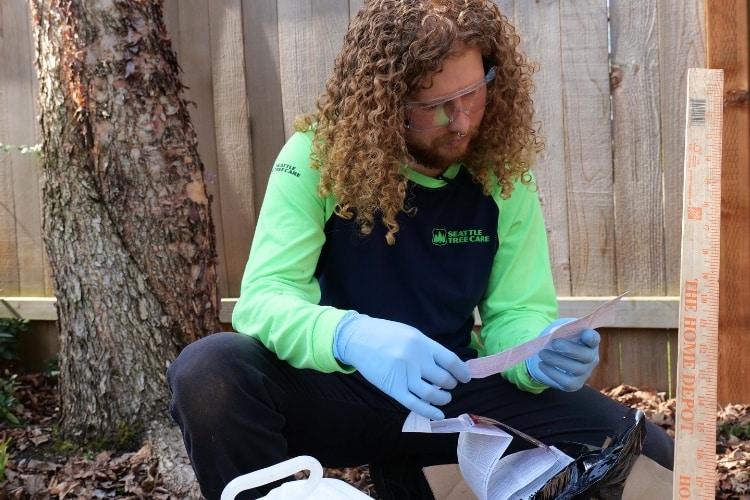
Professional soil and tree health testing helps identify stress early and guide proper care.
Creating Drought-Resilient Landscapes in Specific Seattle Neighborhoods
Different Seattle neighborhoods face unique challenges that affect drought protection strategies. Understanding these local conditions helps you make informed decisions about tree care investments.
Magnolia and Queen Anne
These elevated neighborhoods face stronger winds and faster soil drainage. Mature trees like the large conifers common in Magnolia benefit from windbreaks and extra mulching on the windward side. The well-draining soils require more frequent watering but respond quickly to proper irrigation.
Eastside Communities (Bellevue, Kirkland, Redmond)
Heavy clay soils dominate these areas, creating both opportunities and challenges. While clay retains moisture well, it becomes rock-hard when dry, preventing water penetration. Soil amendments like mixing compost into the top 6 inches around trees or adding coarse sand to improve drainage work best here, along with slow-application watering systems.
Many Eastside properties feature mixed native and ornamental plantings. Group plants by water needs and prioritize native species that naturally handle our dry summers.
Central Seattle (Capitol Hill, Wallingford, Wedgewood)
Older neighborhoods with mature canopies create microclimates that can help or hurt individual trees. Large trees provide beneficial shade but also compete for available water. Strategic thinning by professionals can reduce competition while maintaining neighborhood character.
Urban heat island effects are strongest in these dense neighborhoods, making adequate watering even more critical during heat waves.
West Seattle and South Seattle
These areas often have newer developments with younger trees that need different care than established neighborhoods. Young trees require consistent watering but are more adaptable to drought-resistant landscaping changes.
Industrial areas in South Seattle may have soil contamination issues that affect tree health and water uptake, requiring professional soil testing and amendment.
Seasonal Considerations to Help Protect Seattle’s Trees from Drought Stress
Protecting trees from drought isn’t a one-time task; it requires small, intentional steps throughout the year. By following a seasonal care calendar, you can prepare your trees for dry weather before it arrives and give them the best chance to thrive in every season.
Spring (March-May)
- Assess winter damage and plan irrigation upgrades
- Apply compost and refresh mulch before the growing season begins
- Begin supplemental watering if spring rainfall is below normal
- Install or test irrigation systems
Summer (June-August)
- Peak watering season begins
- Monitor trees weekly for stress signs
- Adjust watering schedules based on weather conditions
- Maintain consistent mulch coverage
Fall (September-November)
- Gradually reduce watering as temperatures cool
- Optimal time for deep root watering to help trees prepare for winter
- Plan major irrigation improvements for the following year
- Refresh mulch for winter protection
Winter (December-February)
- Monitor soil moisture during unusually dry periods
- Research and plan irrigation system upgrades
- Take advantage of free wood chip deliveries from tree services
- Schedule professional assessments for spring
When to Schedule a Professional Consultation with a Certified Arborist
While some symptoms indicate drought stress that homeowners can help address with proper watering and care, the following signs suggest more severe damage that requires immediate professional assessment:
- Branch dieback is affecting more than 25% of the canopy
- Bark cracking or peeling on the trunk
- Increased pest activity, like boring insects
- Structural changes such as leaning or root exposure
FAQs About Drought-Related Tree Issues in Seattle
Will homeowner’s insurance cover tree removal if drought damage makes my tree hazardous?
Homeowner’s insurance coverage varies significantly by policy and circumstances. Most policies cover tree removal if the tree falls and damages your home, but preventive removal of hazardous trees is typically not covered.
Contact your insurance agent to understand your specific coverage and document tree conditions with photos if you suspect drought damage poses a risk.
How do I know when a drought-damaged tree is beyond saving and should be removed?
Trees with the following drought symptoms are often beyond recovery:
- More than 50% canopy dieback
- Extensive bark damage throughout the trunk
- Complete leaf loss for an entire growing season
However, some species can survive surprising levels of stress, so professional assessment is essential before making removal decisions, especially given Seattle’s tree protection requirements.
Which Seattle tree species are most drought-resistant?
Native Pacific Northwest species show the best drought tolerance once established. This includes:
- Douglas fir (Pseudotsuga menziesii)
- Western red cedar (Thuja plicata)
- Oregon white oak (Quercus garryana)
- Pacific madrone (Arbutus menziesii)
Do I need a permit to install irrigation for my trees?
Basic irrigation systems typically don’t require permits, but check with Seattle Department of Construction and Inspections for systems involving electrical connections or major landscaping changes. Professional installation ensures compliance with local codes.
Are there safety considerations when implementing tree watering systems around children and pets?
Yes, there are several safety concerns to consider when using tree watering or irrigation systems.
- Avoid creating standing water that attracts mosquitoes or becomes slippery.
- Secure soaker hoses to prevent tripping hazards.
- Ensure electrical connections for automated systems are properly installed and weatherproofed.
- Choose non-toxic mulch materials if children or pets might ingest them.
Should I water my trees during Seattle’s rainy winters?
Generally, you do not need to water your trees during winter in Seattle, as our winter rainfall provides adequate moisture. However, check soil moisture during unusually dry winter periods, especially for newly planted trees or those under large roof overhangs that may block natural precipitation.
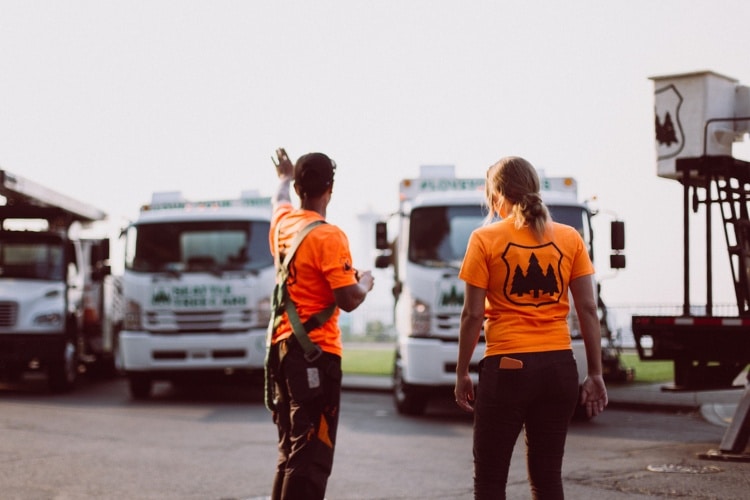
Protect Your Trees with Professional Drought Care from Seattle Tree Care
Seattle’s changing climate makes proactive tree care more important than ever. Don’t wait until you see obvious stress symptoms – by then, the damage may already be irreversible. Seattle Tree Care’s ISA Certified Arborists can assess your trees’ drought vulnerability and create a customized protection plan that fits your budget and landscape needs.
Call 206-789-0534 for a free consultation or request an estimate online to help protect your trees for years to come.
SEE MORE ARTICLES FROM OUR b(LOG)
We've got you covered with tips, resources, updates, how-to's, and other helpful information about trees and landscapes in Seattle, Puget Sound, and King County, WA. Join the thousands of smart local residents who get the monthly newsletter from Seattle Tree Care for helpful information you won't want to miss!
There's no spam - we promise! We are committed to keeping your e-mail address confidential. We do not sell, rent, or lease our contact data or lists to third parties.

